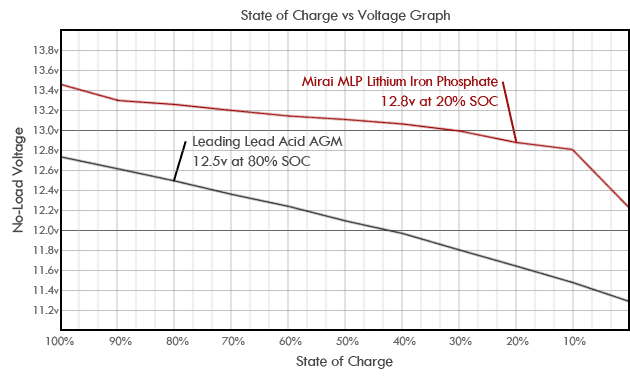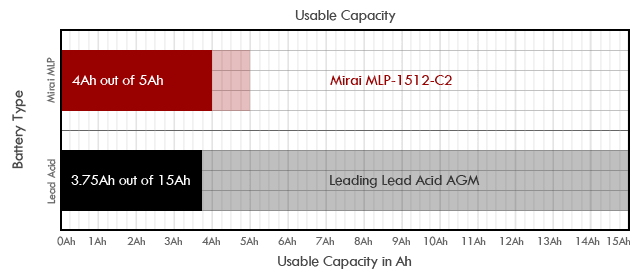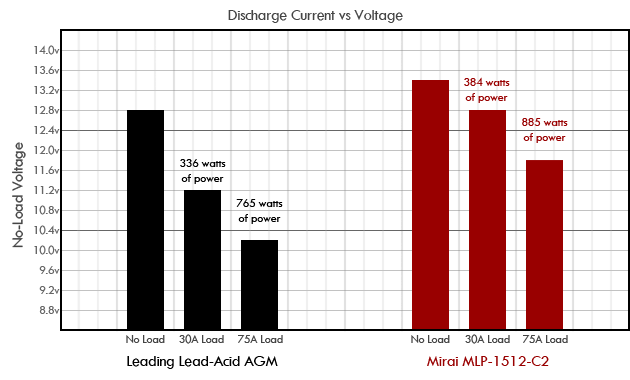1. Why should I get a lithium starter battery?
Lithium batteries provide multiple advantages over standard lead-acid batteries for engine starting use that we'll outline below:
 Substantially lighter - Lithium batteries are just a fraction of the weight of the original lead-acid battery. For comparison, to replace a 9.70lbs Yuasa YTX14-BS used on numerous motorcycles, the Mirai MLP-1512-C2 weighs just 1.74lbs for a weight savings of 7.96lbs. That's an 82% weight reduction which could cost you hundreds or thousands of dollars in aftermarket parts if you were to try to save that much weight elsewhere.
Substantially lighter - Lithium batteries are just a fraction of the weight of the original lead-acid battery. For comparison, to replace a 9.70lbs Yuasa YTX14-BS used on numerous motorcycles, the Mirai MLP-1512-C2 weighs just 1.74lbs for a weight savings of 7.96lbs. That's an 82% weight reduction which could cost you hundreds or thousands of dollars in aftermarket parts if you were to try to save that much weight elsewhere.
 More powerful - Lithium batteries we utilize operate at a higher voltage than standard lead-acid battery, giving you more power across the chart. Lead-acid batteries drop to just 12.5v when only 20% of the battery capacity is used, but lithium batteries provide over 12.8v even when only 20% of the battery capacity is remaining! Refer to the below graph to see the whole story:
More powerful - Lithium batteries we utilize operate at a higher voltage than standard lead-acid battery, giving you more power across the chart. Lead-acid batteries drop to just 12.5v when only 20% of the battery capacity is used, but lithium batteries provide over 12.8v even when only 20% of the battery capacity is remaining! Refer to the below graph to see the whole story:

 Lower self-discharge rate - Lead-acid batteries lose 4%-25% of their charge every month depending on the quality of the plates and separators used. If you leave a vehicle unattended for a month, the lead-acid battery might lose so much power that the vehicle might not start. On the other hand, our lithium battery chemistry loses less than 3% of charge per month, you can go for several months without having to worry. Of course, you should always check to make sure there are no additional power draining devices attached to the battery.
Lower self-discharge rate - Lead-acid batteries lose 4%-25% of their charge every month depending on the quality of the plates and separators used. If you leave a vehicle unattended for a month, the lead-acid battery might lose so much power that the vehicle might not start. On the other hand, our lithium battery chemistry loses less than 3% of charge per month, you can go for several months without having to worry. Of course, you should always check to make sure there are no additional power draining devices attached to the battery.
 Safer and easier to handle - Mirai MLP batteries contain no toxic substances and RoHS free; there is no toxic lead, no corrosive sulfuric acid and as a result, no possible way for an explosive gassing event that occurs with lead-acid batteries. In addition, there is no need to maintain acid levels and worry about venting. Mirai MLP batteries can be installed in any orientation, and the only maintenance involved is just to ensure the battery never gets beyond 80% drained to ensure optimal life.
Safer and easier to handle - Mirai MLP batteries contain no toxic substances and RoHS free; there is no toxic lead, no corrosive sulfuric acid and as a result, no possible way for an explosive gassing event that occurs with lead-acid batteries. In addition, there is no need to maintain acid levels and worry about venting. Mirai MLP batteries can be installed in any orientation, and the only maintenance involved is just to ensure the battery never gets beyond 80% drained to ensure optimal life.
 Long lasting - Cheap lead-acid batteries usually only last 1 to 2 years while gel and AGM lead-acid batteries last 3-5 years with proper maintenance. However, Mirai MLP batteries can provide 12-15 years of use, easily exceeding the life of any lead-acid battery. Battery life depends purely on proper operation and maintenance, so use common-sense and ensure the battery does not drain beyond 80% discharge. Mirai MLP batteries come with a 3 year pro-rated warranty. Refer to the below chart to see the advantage in battery cycle life:
Long lasting - Cheap lead-acid batteries usually only last 1 to 2 years while gel and AGM lead-acid batteries last 3-5 years with proper maintenance. However, Mirai MLP batteries can provide 12-15 years of use, easily exceeding the life of any lead-acid battery. Battery life depends purely on proper operation and maintenance, so use common-sense and ensure the battery does not drain beyond 80% discharge. Mirai MLP batteries come with a 3 year pro-rated warranty. Refer to the below chart to see the advantage in battery cycle life:

2. What advantages does Mirai MLP offer over other lithium starter batteries?
Mirai utilizes the latest advancements in lithium battery technology to bring you the best battery for your vehicle, we'll go through each below:
 Best quality electrolytes - Mirai MLP series batteries utilize brand new, high purity and high quality electrolytes sourced from Japanese suppliers. We do not use recycled lithium and do our best to minimize impurities with our production processes which we have developed over years of experience with military, space and aviation applications. The quality of the raw materials is tantamount to ensuring a long-lasting, consistent performing cell. The cells are made over a 12 week period where we begin with a 6 week long material settling process followed by individual cell testing and cell matching to ensure consistent internal resistance between the cells in a pack; a very long and tedious procedure, but essential in bringing a quality product to the market. This combined with our strict quality control and mass production technologies allow us to make the finest batteries at the most attractive price points.
Best quality electrolytes - Mirai MLP series batteries utilize brand new, high purity and high quality electrolytes sourced from Japanese suppliers. We do not use recycled lithium and do our best to minimize impurities with our production processes which we have developed over years of experience with military, space and aviation applications. The quality of the raw materials is tantamount to ensuring a long-lasting, consistent performing cell. The cells are made over a 12 week period where we begin with a 6 week long material settling process followed by individual cell testing and cell matching to ensure consistent internal resistance between the cells in a pack; a very long and tedious procedure, but essential in bringing a quality product to the market. This combined with our strict quality control and mass production technologies allow us to make the finest batteries at the most attractive price points.
 High surface anode prismatic cells - We've taken prismatic cells to the next level with our high surface area anodes. Prismatic cells have an obvious advantage over cylindrical cells in which it offers the greatest flexibiliy in battery sizing. Using high quality electrolytes combined with a higher surface area anode material allows us to extract the same high-discharge rates that previously gave cylindrical cells the one single advantage over the years. The prismatic design also allows for more margins of safety with cell expansion over a wide temperature range.
High surface anode prismatic cells - We've taken prismatic cells to the next level with our high surface area anodes. Prismatic cells have an obvious advantage over cylindrical cells in which it offers the greatest flexibiliy in battery sizing. Using high quality electrolytes combined with a higher surface area anode material allows us to extract the same high-discharge rates that previously gave cylindrical cells the one single advantage over the years. The prismatic design also allows for more margins of safety with cell expansion over a wide temperature range.
 Unique dual-terminal design - Another design unique to the Mirai MLP is a dual-terminal design which allows for one battery to adapt to two different mounting positions. Whereas in the past, you had to get a specific battery for your application based on polarity, our dual-terminal design allows you to easily switch battery polarity allowing for more flexibility.
Unique dual-terminal design - Another design unique to the Mirai MLP is a dual-terminal design which allows for one battery to adapt to two different mounting positions. Whereas in the past, you had to get a specific battery for your application based on polarity, our dual-terminal design allows you to easily switch battery polarity allowing for more flexibility.
3. What does a PbEqv Amp-Hour capacity mean and how does it compare?
There are three types of lead-acid batteries out there, the first is geared towards energy storage (deep cycle), the second provides a balance of energy storage and delivering maximum current (marine or leisure), and third is geared towards delivering maximum current in short bursts (starter). For use in cars, motorcycles and powersports, only the last one applies.
Lead-acid batteries used for starting purposes are designed only to provide the maximum current to start your vehicle. The lead plates used are thin to increase surface area to extract the most current, but if you discharge the battery too much, the lead plate electrodes begin to disintegrate due to mechanical stress. As a result, if the plates fragment inside the battery, they have the potential to touch other nearby plates and short circuit, resulting in a battery that no longer functions. Typically starter batteries can only be discharged about 20%~25% before the plates begin the process of disintegration. Any further than that will quickly reduce the total life of the battery, so a lead-acid battery rated for 15Ah has only about 3~3.75Ah of usable capacity.
Mirai MLP's lithium chemistry allows the battery to be discharged to a greater percentage than a lead-acid starter battery. In fact, it is possible to discharge 80% while retaining a higher voltage and cranking power than a lead-acid battery. As a result, a lithium battery with just 5Ah capacity has 4Ah of usable capacity! To level the playing field when comparing the two technologies, we've adopted a PbEqv (lead equivalent) rating. Our battery with a 15Ah PbEqv rating uses 5Ah cells which offer 4Ah (80% x 5Ah) of usable capacity. A 15Ah lead acid battery offers 3.75Ah (25% x 15Ah) of usable capacity. Refer to the below diagram for an easier understanding:

4. How does the CCA ratings compare between lithium and lead-acid batteries?
CCA, or Cold Cranking Amperes, is defined as the amount of current a lead-acid battery can provide at 0°F (-18°C) for 30 seconds and maintain at least 1.2v per cell, which for a 6 cell 12v battery equates to 7.2v. The idea behind this definition is, in colder environments, batteries cannot push out as much current, starter motors have to overcome greater resistance from the lubricants having higher viscosity and fuel ignition is harder to achieve. Problem is, anyone who's worked with vehicles knows that 7.2v isn't enough to start an engine in a vehicle with a 12v power system and as such, the CCA is no more than an arbitrary figure, and one that is most misused and misrepresented.
First of all, both lead-acid and lithium cells have increased internal resistance as the temperatures fall. Lithium batteries have more internal resistance in extreme cold, temperatures of 0°F (-18°C) or lower, however, the batteries can be warmed up much quicker simply by putting a load on the battery, such as turning on your headlights for 15 to 30 seconds. Since the Mirai MLP batteries have substantially lower mass than lead-acid batteries, they warm up much quicker and can deliver their normal crank ratings. The other aspect to consider is the voltage which we explore in a little more detail below:
 Cars and motorcycles need at least 11v to start reliably, anything below that and the crank won't even turn and vehicles with modern electronics won't power up at all. A fully charged 15Ah lead-acid battery with a 200 CCA puts out 12.8v under zero load. However, at 2C discharge (which means discharging at 2 times the battery's capacity, i.e. 2 x 15A = 30A), the voltage drops to 11.2v for a total power deliver of 336 watts (30A x 11.2v), and at 5C discharge (75A), it drops even further to 10.2v and delivers 765 watts (75A x 10.2v). A motorcycle using such a battery draws about 75-100 amps for under a second for the starter motor to initially spin and afterwards draws 30-50 amps to keep the starter motor spinning so it never comes close to drawing 200 amps - the lead-acid battery can only put out 7.2v at that rating so it couldn't start the engine anyway if it did!
Cars and motorcycles need at least 11v to start reliably, anything below that and the crank won't even turn and vehicles with modern electronics won't power up at all. A fully charged 15Ah lead-acid battery with a 200 CCA puts out 12.8v under zero load. However, at 2C discharge (which means discharging at 2 times the battery's capacity, i.e. 2 x 15A = 30A), the voltage drops to 11.2v for a total power deliver of 336 watts (30A x 11.2v), and at 5C discharge (75A), it drops even further to 10.2v and delivers 765 watts (75A x 10.2v). A motorcycle using such a battery draws about 75-100 amps for under a second for the starter motor to initially spin and afterwards draws 30-50 amps to keep the starter motor spinning so it never comes close to drawing 200 amps - the lead-acid battery can only put out 7.2v at that rating so it couldn't start the engine anyway if it did!
 In the same scenario as above, a Mirai MLP-1512-C2 delivers 13.4v under zero load. Since it is a 5Ah battery, 30 amps would be 6C, at which point the voltage it delivers drops just a little to 12.8v and delivers 384 watts (30A x 12.8v). At 15C discharge (75A), it drops to 11.8v and delivers 885 watts (75A x 11.8v). As you can see, it's important not just to take the current into consideration, but you must factor in the voltage to see how much power the battery delivers. Since the lithium battery delivers higher voltage at any current, it is guaranteed to give you more starting power than a lead-acid battery of an equivalent CCA. See the below drawing to see the advantage of Mirai MLP:
In the same scenario as above, a Mirai MLP-1512-C2 delivers 13.4v under zero load. Since it is a 5Ah battery, 30 amps would be 6C, at which point the voltage it delivers drops just a little to 12.8v and delivers 384 watts (30A x 12.8v). At 15C discharge (75A), it drops to 11.8v and delivers 885 watts (75A x 11.8v). As you can see, it's important not just to take the current into consideration, but you must factor in the voltage to see how much power the battery delivers. Since the lithium battery delivers higher voltage at any current, it is guaranteed to give you more starting power than a lead-acid battery of an equivalent CCA. See the below drawing to see the advantage of Mirai MLP:



